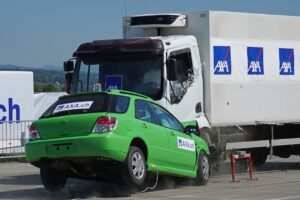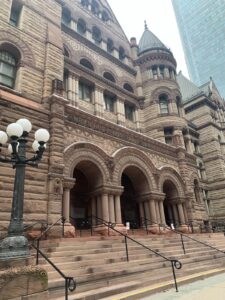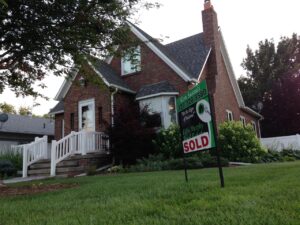
By Abby O’Brien, published on February 3, 2023 at 4:00 PM Eastern Time.
The image above shows speed limit signs in Ontario, taken on Wednesday, March 17, 2021. (CTV News)
A Toronto family was sued for speeding by a city-operated speed radar, but a small detail led to their successful appeal in court.
The driver identified in the court proceedings is Brian Kumar, who was caught on camera by an Automated Speed Enforcement (ASE) camera (open in a new tab) while driving on Avenue Rd. just after 3 a.m. on August 15, 2021.
Kumar, 35, was driving to his girlfriend’s place when, according to court documents, an ASE camera recorded him traveling at approximately 121 km/h, 71 km/h above the speed limit.
He was automatically issued a ticket under Toronto’s ASE program, which was implemented in 2019 (opens in a new tab) .
Kumar faced a $1,400 fine, challenged the penalty, and ultimately won his case.
In December, the Ontario court dismissed the charge, with Magistrate Roger Rodriguez stating that the prosecution could not prove Kumar was traveling at 121 km/h before a reasonable doubt could be reached.
In his ruling, Rodriguez stated, “When I take into account the overall impact or nature of the defendant’s innocence, which remained unshaken during cross-examination, and the weaknesses in the prosecution’s evidence, I have reasonable doubt about the defendant’s guilt.” (Open in a new tab )
Kumar’s defense and ultimate victory hinged on one factor: whether the automatic speed camera that recorded his speeding was in reliable working order. During cross-examination, the prosecution failed to demonstrate the camera’s accuracy and routine maintenance.
Despite the City of Toronto’s insistence on the accuracy and reliability of its photo-radar program, legal experts say Kumar’s case could set a precedent for future challenges to ASE penalties.
case
When an Automated Parking Surveillance (ASE) camera automatically issues a ticket, the name on the ticket is that of the vehicle owner. ASE cameras cannot distinguish or identify the driver. As with all ASE violations, the potential consequences are limited to a fine (which opens in a new tab) .
The documents show that Kumar’s mother, Omar Ramrup, is listed as a defendant in the case.
According to the judgment, Kumar insisted in his testimony that he never exceeded 50 km/h on that night in August. He testified that he frequently drove on the avenue and was therefore aware of the recently installed speed traps. For this reason, Kumar testified that he “always” set his vehicle’s cruise control speed to “47 or 48 km/h” when turning onto the road.
Kumar also told the court that he had been driving since he was 16 and knew what it “feels” like to go at 121 km/h.
David Bowers, the officer in charge of verifying the ASE photos that led to Kumar’s charges, also testified that the vehicle’s license plate was clearly visible in the images taken by the ASE camera, and the camera readings showed a speed of 121 km/h.
However, when the defense cross-examined Bowers and questioned him about the installation and maintenance of the equipment, he was unable to provide sufficient and necessary background information.
The documents show that Bowers could not specify which company was responsible for certifying the camera’s accuracy, nor could it state when the camera was last tested for accuracy. According to the law, every device must be calibrated within 12 months prior to the alleged violation.
The judgment did not mention the accuracy certificates of the ASE cameras that issued the ticket to Kumar submitted to the court as evidence. The city government lists accuracy certificates for each camera on its website (opens in a new tab) .
During the cross-examination, documents state Powers also erroneously claimed that in the photograph captured of Ramroop’s vehicle, only one vehicle was present when, in fact, there were two vehicles visible.
In turn, Rodrigues wrote in his decision that the officer’s cross-examination “materially lessened” the strength of his evidence, while Kumar’s testimony “contained adequate detail to be considered plausible,” and determined that the prosecution had failed to prove beyond a reasonable doubt that the vehicle had been speeding.
The City of Toronto is currently reviewing the decision, it said in an emailed statement to CTV News Toronto.
“In the meantime, it is important to understand every case is adjudicated on its own merits and an acquittal in this case in no way means Toronto’s ASE system is not accurate or reliable,” the statement read.
A PRECEDENT?
When reached for comment, paralegal Paul Periti, representation for Ramroop, told CTV News Toronto said he believes he “brought some doubt to the prosecution’s case through cross-examination,” but that the bulk of the doubt came simply from the driver’s testimony.
“The defendant’s son who was driving the vehicle denied the accused rate of speed and described very eloquently how fast he was travelling,” he said.
Dylan Finlay, trial lawyer at Oykhman Criminal Defence in Toronto, told CTV News Toronto Friday that Kumar’s case could lay a path for future ASE court challenges.
“I don’t think it’s a new loophole,” Finlay said.
“But yes, the questions [the officer] was asked, and what he was shaken on, certainly lays a path for other people challenging tickets in the future.”
While Periti said he cannot comment on the “overall reliability” of the city’s ASE cameras, he said he is wary of the system and questions whether it prioritizes profits over safety.
For years, the city has been moving away from ASE ticket challenges being heard in court, and instead towards administrative penalty tribunals(opens in a new tab), which are headed by hearing officers rather than judges. The move is meant to free up the court system and alleviate backlogs, the city said.
But Periti disavows this decision, claiming it infringes upon Ontarian’s right to fight such charges in a court of law.
“It [can] become an accusation and just pay with no opportunity to go before the unbiased Judiciary in this province – you appeal to the city who accused you,” he explained.
On Feb. 2, while revealing the locations of 25 new ASE cameras across the city(opens in a new tab), Toronto Mayor John Tory reiterated that the program’s top priority is road safety, and stated that the cameras have been successful in lowering some driver’s speeds.
City statistics (open in a new tab) show that between July 2020 and November 2022, Toronto’s speed cameras issued more than 590,000 tickets. During the same period, the city collected $34 million in fines (open in a new tab) .







